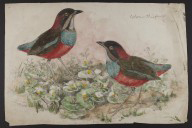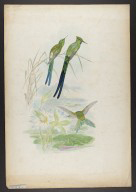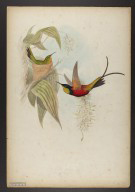KU Libraries digitizes collection of world-famous bird illustrator John Gould's books, images
LAWRENCE — University of Kansas Libraries has completed digitization of one of the world’s greatest collections of bird illustrations. The 19th century books of John Gould feature images of birds from around the world and have long appealed to everyone from Charles Darwin to amateur bird watchers.
 Gould’s work came to KU in the early 1950s and became one of the original collections of the Kenneth Spencer Research Library. As well as his published books, the Gould collection includes more than 2,000 manuscript drawings, watercolors and preliminary art for the books. The content of the books and manuscripts, about 6,000 images total, are now available online for anyone to access at the KU Libraries website. The digitization project was partially supported by a grant from the National Endowment for the Humanities.
Gould’s work came to KU in the early 1950s and became one of the original collections of the Kenneth Spencer Research Library. As well as his published books, the Gould collection includes more than 2,000 manuscript drawings, watercolors and preliminary art for the books. The content of the books and manuscripts, about 6,000 images total, are now available online for anyone to access at the KU Libraries website. The digitization project was partially supported by a grant from the National Endowment for the Humanities.
 Gould produced approximately 47 large-format 22-by-14-inch volumes of bird illustrations and scientific descriptions between 1830 and 1881. A skilled taxidermist with the ability to sketch birds, he was named curator and preserver of bird collections at the Museum of the Zoological Society of London at the age of 24. In 1829 he married Elizabeth Coxen, herself a talented amateur artist. Together they began producing books about birds and raising a family. The first, “A Century of Birds Hitherto Unfigured from the Himalaya Mountains,” was published in 1830. Though Elizabeth died in 1841, John continued his work until his death in 1881.
Gould produced approximately 47 large-format 22-by-14-inch volumes of bird illustrations and scientific descriptions between 1830 and 1881. A skilled taxidermist with the ability to sketch birds, he was named curator and preserver of bird collections at the Museum of the Zoological Society of London at the age of 24. In 1829 he married Elizabeth Coxen, herself a talented amateur artist. Together they began producing books about birds and raising a family. The first, “A Century of Birds Hitherto Unfigured from the Himalaya Mountains,” was published in 1830. Though Elizabeth died in 1841, John continued his work until his death in 1881.
The volumes were both scientifically informative and beautiful works of art. Gould often began the process of illustration with rough field sketches that he passed on to his wife and other artist employees. They added color and detail. Many of their drawings and watercolors in KU’s collection bear Gould’s handwritten notes indicating necessary changes to the proportions, positions and coloring of the birds.
 “At the time lithographic color printing was still in its infancy,” said Karen Severud Cook, special collections librarian at KU. “So all of his published illustrations were colored by hand.”
“At the time lithographic color printing was still in its infancy,” said Karen Severud Cook, special collections librarian at KU. “So all of his published illustrations were colored by hand.”
The expense of the deluxe volumes limited their affordability to wealthy collectors and well-funded museums and libraries. Eventually reduced copies of the images were published in smaller volumes that were more affordable for the wider public.
In his career Gould illustrated birds of the Himalayas, Australia, New Guinea, Asia, Europe and Great Britain and also published volumes about various families of birds. His only work on North American birds was about partridges, but following his death his work became more popular with Americans. Gould first saw hummingbirds, not native to England, in America and his six volumes about hummingbirds influenced the "hummingbird craze" in mid-19th century England.
Gould’s work was also widely known and respected by scientists of the time. After returning from the voyage of the H.M.S. Beagle in 1836 Charles Darwin presented 450 bird specimens to the Museum of the London Zoological Society.
“So who helped him to describe those birds? It was John Gould,” Cook said. “Darwin published five volumes on his findings from the H.M.S. Beagle and Gould authored the volume about birds, including the finches from the Galapagos Islands.”
The Gould collection made its way to KU thanks to a dedicated collector with Kansas connections. Ralph Ellis was born in 1908 and showed an interest in birds since childhood. That interest grew into an obsession to collect books on birds as he grew older. An aspiring ornithologist, Ellis collected more than 65,000 books and items about birds, including the original works of John Gould, which he acquired in England in 1936 and 1937.
Ellis knew E. Raymond Hall, who became director of KU’s Natural History Museum in 1944. Hall arranged for a meeting between Ellis and then-chancellor Franklin Murphy. Murphy was sufficiently impressed by the collection and saw the value in housing Gould’s work, even though there was not a library dedicated to such works at the university at the time. In 1945 Ellis was moving his collection, which filled two railway freight cars, cross-country when accepted Hall’s invitation to come to Lawrence. Six months later Ellis died of pneumonia and bequeathed the collection to KU.
Since then, scientists, educators, students, artists and bird enthusiasts have come to see and study the John Gould Ornithological Collection.
“There isn’t one specific group these images appeal to the most,” Cook said. “We’ve had ornithologists, art classes and even people on their way to birding events who have stopped here to see the originals.”
However, other potential visitors haven’t been able to travel to Kansas to see the works in person or have not even known of their existence.
The NEH grant has allowed KU Libraries to digitize, catalog and preserve the thousands of images and make them available to anyone with an Internet connection. Available online, the collection can be searched by volume, by artist who worked with Gould, by species and more. Viewers can also view the images in digital book form and zoom in to enhance the detail and study the composition of the works.
KU Libraries will host an event from 5:30 to 7 p.m. Thursday, Sept. 11, at Spencer Research Library to introduce the digitized collection to the public and share information on the creation of the original images as well as their digitization and preservation.
“This was one of the foundation collections of Spencer Research Library and is a wealth of information and excellent images,” Cook said. “It really needed the digital age, though, to complete its processing and present it in digital format, allowing anyone who wishes to view it online.”